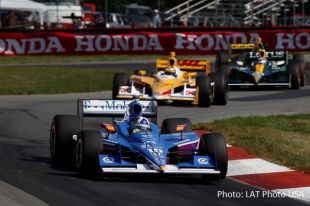Mid-Ohio: How can we wake up a snoozer?
IndyCar commentary — By Steph Wallcraft on August 8, 2011 3:57 pmDuring the post-race press conference for yesterday’s Honda Indy 200 at Mid-Ohio Sports Car Course, I had the opportunity to ask all three podium finishers for their thoughts on changes that could allow for more overtaking opportunities and make the event more exciting for viewers on television. Each of the drivers had different and valuable suggestions that warrant further examination.
Ryan Hunter-Reay’s thoughts turned to mitigating the impact of fuel-mileage racing. “When I was in CART and Champ Car, I had a good time with the mandatory fuel windows and just going hellbent for the laps that we were green,” he said. “It was just fun attacking and not having to save fuel.”
Scott Dixon looked to the tires as a possible solution. “I think one of the best races of recent past for me was actually Sonoma last year, and that’s where the red tire just degraded rapidly,” he said. “It was done within ten laps and there were chunks falling off. I think that’s a good way. Obviously, you see it in Formula 1, too, where they are having to do four or five pit stops.”
Dario Franchitti started his comments with a counterargument to Dixon’s point. “I think Firestone take great pride in the consistency of their tire, and they always have,” he started. “I think that’s one reason we don’t see a situation like we see in F1 because they just won’t build a bad tire.” He continued by looking at changes to the track itself as the answer. “The owners [Green Savoree Promotions] were kind of asking some ideas of maybe changing the track down the road,” he said. “Only I would say in small places, not a complete re‑design, but just maybe changing one corner or something. And I think that would promote passing here. It’s just the two places, Turn 2 and Turn 4, you have very early and quite fast entries into both those corners, and it just means you can’t get alongside to make a move.”
Of course, this all may wind up being a moot point with the new car specifications being introduced in 2012. But in my highly unprofessional opinion, I tend to side with Dixon. Firestone’s desire to make the best tire possible is completely understandable, but tire degradation created very interesting storylines coming out of Sonoma last year and rescued that race from its usual Snore-noma designation. Creating that same scenario with the red tires at every road and street course event is an solution that can have an immediate impact on the quality of the racing without needing to wait until 2012 or make sweeping changes to the schedule. I certainly wouldn’t look at the quality of Firestone’s products in a different light were they to take this route, and I don’t believe many others would, either.
What do you think, fans? Do any of these comments from the drivers speak to you, or is there another solution that you think would work better? Let us know your thoughts in the comments section below.
Tags: Mid-Ohio Sports Car Course








Another way to phrase the question would be “what could be done to increase the opportunities for cars to change position?” One thing is already being done, the 2012 car. Having a variety of engine and aero combinations should spread out the lap times through the field. So you’ll have a bigger delta between the fast cars and the slow cars.
Changing the tire compounds is a reasonable move. That could be in the form of a bigger difference in the grip levels or in the wear rate. Grip level would affect lap times and wear rate would affect number of pit stops.
Another way to increase the number of stops is to reduce the size of the fuel cell. In my opinion an Indycar event should necessitate at least three pit stop and four or five would be even better.
I’m onw who loves to see racing action. One thought that always appealed to me was to make yellow flag laps not count toward the race distace, It would change a lot of the boring fuel saving type races we see so often.